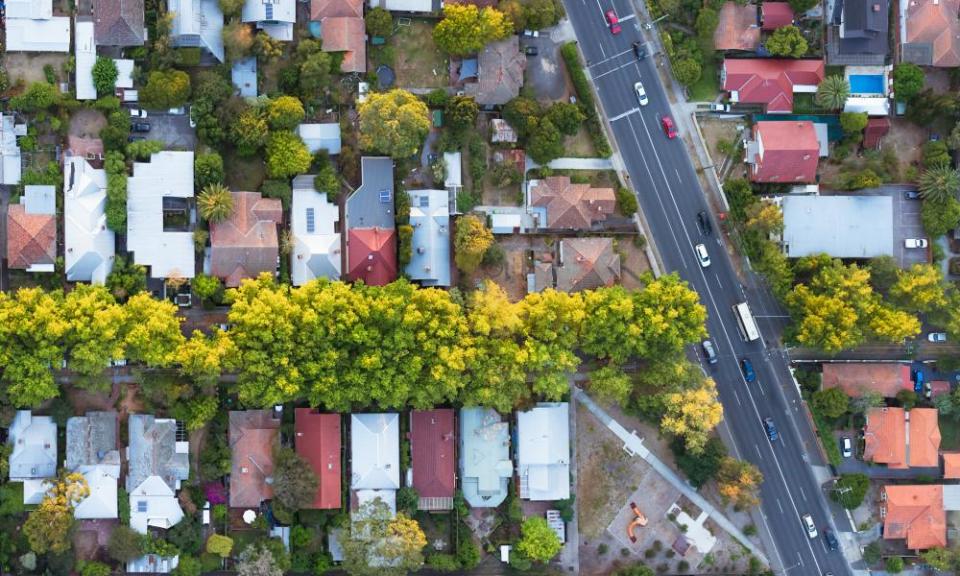Australians told to expect 'longest and deepest' housing slump

Australians should prepare for the “longest and deepest” housing downturn in the country’s modern history as the full effects of tighter credit and rising mortgage rates are felt, a leading economist has warned.
As figures released on Monday showed that house prices fell across Australia for the 11th consecutive month in August, Paul Dales, the chief economist for Capital Economics in Australia, said values could slide by 12% over the next four years.
Shane Oliver, AMP Capital’s chief economist, also weighed in, telling clients that property prices in Sydney and Melbourne may decline 15% by 2020, implying they have another 10% to lose, given the falls they have already recorded.
The Reserve Bank will make its September decision on interest rates on Tuesday, when it is expected to keep the official cash rate steady at a record low 1.5%.
Falling house prices were also blamed for a flatlining in retail spending in July. Figures released by the ABS on Monday showed that spending on non-food items fell, with an especially sharp fall in household goods (down 1.2%) and department store spending (down 1.9%).
“Ongoing home price falls in Sydney and Melbourne will depress consumer spending as the wealth effect is now going in reverse,” Oliver said.
Data on the housing market from CoreLogic, released on Monday, showed prices were down 2.2% since their peak in September 2017, with Sydney, Melbourne and Perth leading the decline.
Last month, five of Australia’s eight capital cities recorded a fall in values: Sydney (-0.3%), Melbourne (-0.6%), Brisbane (-0.2%), Perth (-0.6%), and Hobart (-0.1%). The only cities where dwelling values edged higher were Adelaide (0.3%), Darwin (0.1%) and Canberra (0.5%). Over the past 12 months, prices in Sydney have fallen 5.6% while Melbourne has seen a decline of 1.6%.
Economists are now warning property prices will decline for a number of years, albeit slowly.
Dales says the housing downturn has already lasted longer than the 12-month average of Australia’s seven previous housing downturns since 1980, but the price declines in this downturn have been the smallest on record.
“Overall, a 12% fall in house prices spread over four years is unlikely to cause too many problems,” he said.
“But by prompting households to spend more cautiously, it will probably contribute to GDP growth being closer to 2.5% over the next few years rather than the rates of 3% or more the RBA is banking on.”
“With the full effects of tighter credit conditions and rising mortgage rates yet to be felt, the current housing downturn will probably end up being the longest and deepest in Australia’s modern history.”
Oliver noted that prices in Sydney rose 72% over five years to their August 2017 high, and Melbourne prices rose 57% over five years to their November 2017 high, so the current price declines are taking place in a context of recently strong capital gains.
But he expects the declines, particularly in Sydney and Melbourne, have a while to go.
“Tighter bank lending standards, poor affordability, rising unit supply, falling price growth expectations and FOMO (fear of missing out) risking turning into FONGO (fear of not getting out) for investors, are pushing prices down in cities which have seen strong gains since 2012,” he said.
“A crash landing remains unlikely in the absence of much higher interest rates or unemployment, but it’s a risk given the difficulty in gauging how severe the tightening in bank lending standards in the face of the royal commission will get and how investors will respond as their capital growth expectations collapse at a time when net rental yields are around 1-2%.”
Tim Lawless, CoreLogic’s head of research, said weaker housing market conditions can be explained by a variety of factors, “foremost of which is the tighter credit environment which has slowed market activity, especially amongst investors.”
“Fewer active buyers has led to higher inventory levels and reduced competition in the market. Collectively, these factors have been compounded by affordability challenges, reduced foreign investment and a rise in housing supply,” he said.
He said the price declines may depress consumer spending because the “wealth effect” is now working in reverse, so homeowners will be less inclined to allow their savings rate to decline in coming years.
Retail sales figures, also released on Monday, show retail sales were flat in July, dampening the momentum of a reasonable June quarter.
“Sales growth is being dragged by margin compression, tighter financial conditions for households, and falling housing turnover,” JP Morgan’s Ben Jarman said.

 Yahoo Finance
Yahoo Finance 